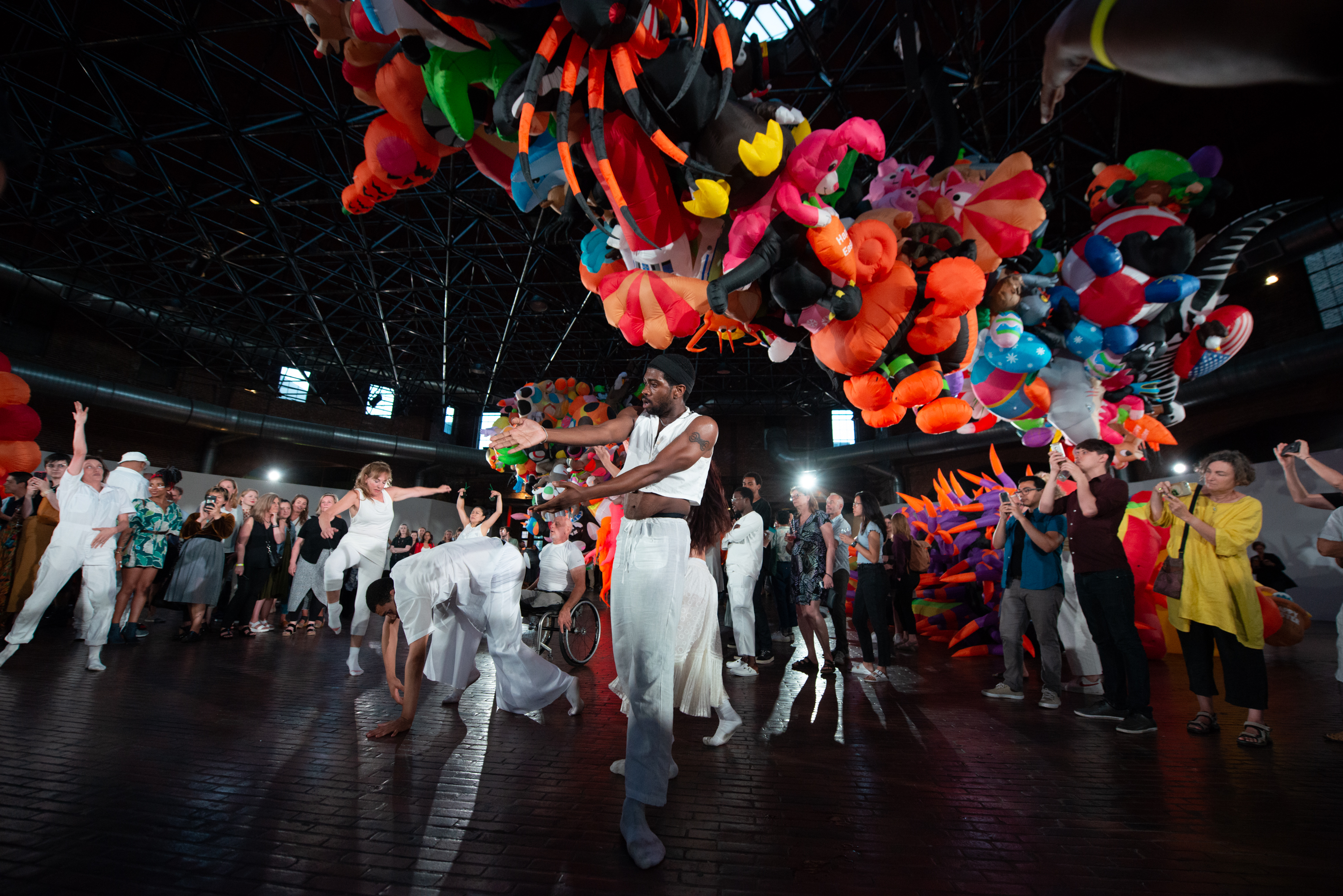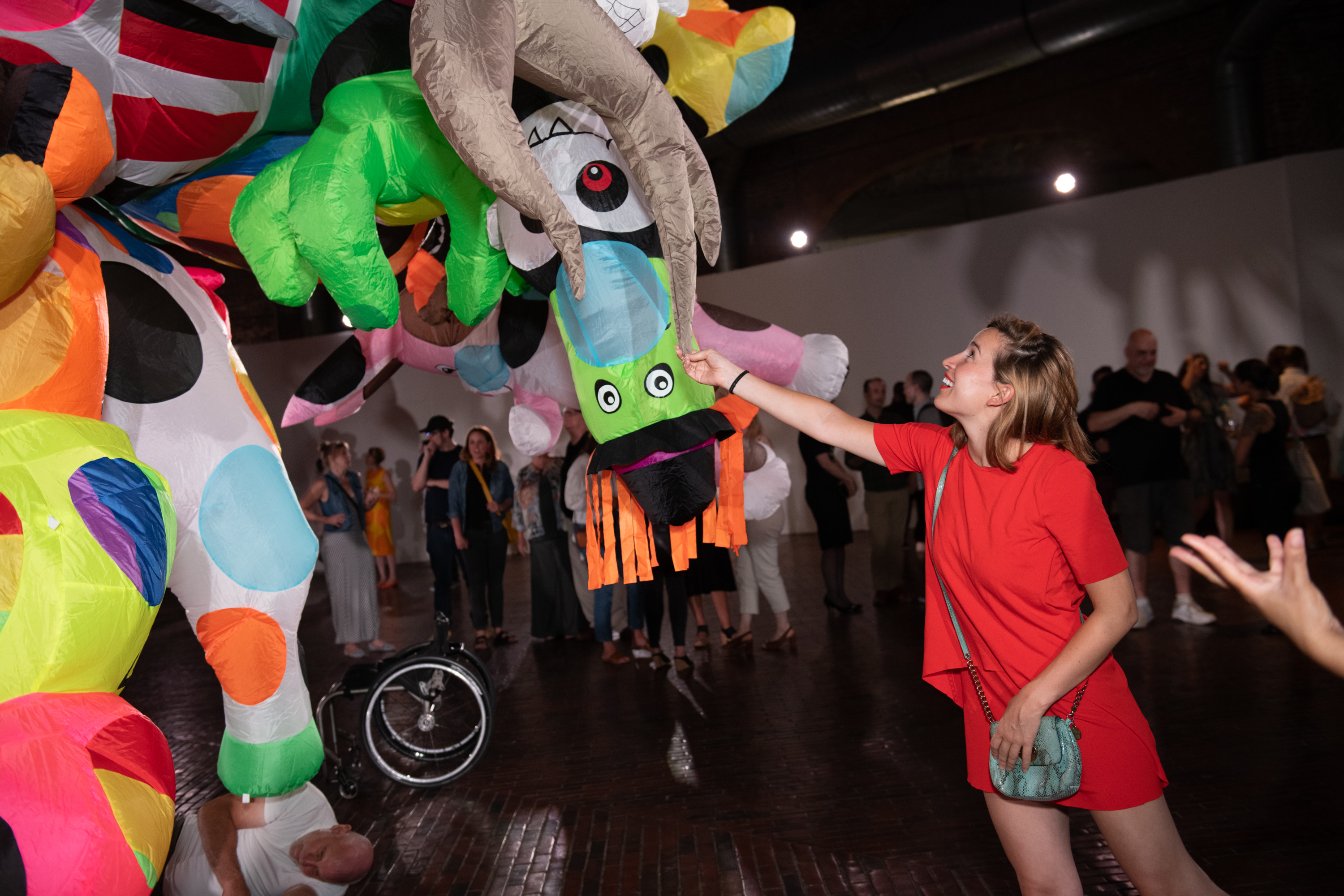
For Nick Cave, art is all about happiness: what it is, what it means to us, and how to find it in a world so often overshadowed by injustice. His project Augment, made in collaboration with public art curatorial agency Now + There, takes over the city of Boston from the South End to Upham’s Corner. The central sculpture is sewn by Cave himself (with help post-production) and made up of over 1,000 repurposed inflatable lawn ornaments. Bursting with bright colors, and inspired by the joy one feels around the holidays, the piece looks almost alive due to its timed inflating and deflating. On August 8, Cave’s latest project was launched with an exhibit of the sculpture at Cyclorama. On September 14, it will be paraded through Boston to meet the other half of the project: an amalgamation of collages created by the Upham’s Corner community lead by local artists and the Design Studio for Innovation (DS4SI). By combining these two parts of Augment, Cave hopes to unite the communities within Boston and spark joy in every person. Here, he talks about his childhood inspirations and how he hopes his work will make the city feel.
Did you find art in your childhood? I come from a family history of makers. My mother comes from a family of 18 where there were amazing seamstresses, my grandmothers were amazing quilt makers. One grandmother would make all of her kids Halloween costumes, or anything worn for a school performance which she would make from scratch, she’d be drafting her own patterns and all of that. Being able to see that—not that I paid attention to it, in terms of direct attention, but looking over her shoulders thinking, what is she doing? What is she making? Then I had my grandfathers who were all carpenters and furniture makers, so I was always surrounded by that. There were certainly moments where I was around it, like talking to one of my grandmothers while she was quilting after dinner. Those simple moments brought comfort, and have always been interesting to me. My brother Jack is also an artist, and we’d do things like set up a still life and challenge each other: who can paint a watercolor or draw it the fastest? Just ways of staying connected. But I think it was when I was 18, at the Saint Louis Art Museum, when I first had an emotional reaction to an Anselm Kiefer painting. I just started crying standing in front of this painting and these emotions just came on, and it was very interesting to think about how I can have an emotion by looking at art. I think that was a pivotal moment for me, understanding the impact of art and how it can tap into something emotionally.
Who were the people that helped shape you as an artist? I’ve always been interested in the question: how did I get here? I’ve been conditioned by one person and then that person hands me off to the next, which started with my parents paying attention to the fact that they knew their kid was creative. My mother handed me off to school, where my high school art teacher told me to consider art as a career. She was the one who helped me get my portfolio ready to apply to the Kansas City Art Institute, where I did my undergraduate. Then I went to Cranbrook, where I did my masters. It was the teachers, the instructors that I met along the way that really helped me get on course and challenged me and forced me to be responsible. Gerhardt Knodel, who was my professor at Cranbrook, was the one who was always asking us to question the impact of art and the influence it can have on society. We were always thinking about the fantastic, the spectacle of it all. I think that was something that I was curious about, and I was asking myself, what is a spectacle? What is making something larger than life, that could perhaps be viewed as something different? Knodel was the one who made us ask ourselves, what separates you from everyone else? And us grad students were like ugh, I don’t want to get into all of that right now! The burden, the weight of it was very overwhelming, but that is the question that we all have to ask ourselves!

How did your training at Alvin Ailey influence your practice as an artist? Part of the building of my curricula was dance, and the University of Kansas at Kansas City had a dance program that was a part of the Alvin Ailey company, which was my connection. I was interested in movement and I looked at dance as another medium to consider in my practice. Because movement and performance has always been a part of my practice, I wanted to get a better understanding about choreography and the body and space, and how they inform and are an extension of what I’m interested in doing.
Like your previous series Soundsuits, a group of wearable sculptures that you often performed in yourself, Augment also has a strong interactive element. How did your artistic practice evolve between Soundsuits and Augment? Have your artistic themes changed? I think when you look at Augment, it’s still built the way in which I build my work—it’s built through this sense of assemblage, parts and pieces coming together to make a whole. But I think that with Augment, and going forward, I’m interested in happiness, what does that look like, what do we think that is. I think that that’s all been triggered by the country’s political climate, and I was interested in how we find the mechanisms to maintain an optimistic perspective while everything else is going on, especially lately. I’m very interested in the fact that we need both of these things in order to find the center. All of my work, even Augment, when you really get into the details and really break it down, gets very dark and scary in some sense. It’s strange, and erotic in some cases. But it’s interesting how darkness and despair is still part of the presence, the construct of our existence, but it’s also the opportunism and this sense of hope and determination that dominates. So I was interested in this being the critical juncture that empowers me to be as proactive as I possibly can, and then how does this thought transfer to public outreach.
What draws you to the interactive and performative quality in your work? I think with all my work, I try to think about it in terms of options. So with Augment, it’s very static, it’s a sculptural form, but also there’s timers built within the inflatables, so they start to deflate. I’m very interested in the idea of the last breath, or a sort of sense of despair, disappointment and failure—the sense of defeat. But then, all of a sudden, it finds life again. I’m interested in the coping mechanisms that are very much a part of the performative/outreach aspect of my work and the way in which movement can inform a sense of connection and collaboration. It also provides a different kind of perspective—choreography and movement have a different way of informing a space and its relationship to the piece.
What inspired you to make this project now? Why in Boston? I keep an ongoing database of projects that I’m interested in pursuing, so this was an opportunity where I could present one of them. So then I came to Boston and was working very closely with Kate Gilbert, executive director of Now + There, and I wanted to talk about ways we could submerge ourselves within the community here. We were very interested in the parts of the community that were culturally deprived, and we thought, how could we somehow create a piece of work that could bridge two communities together?

I’d love to hear more about each of the individual phases of the show, what does each one bring to the project individually? How do they come together? We created a number of things including collage-based workshops where all of the youth created collages that were then transferred into another Augment that will then wrap a building in Upham’s. That’s another extension of this project. Then all of these inflatables that will be paraded to the other facility in Upham’s as a procession. It’s all interesting, the way in which this project is expanding, and its involvement in the community and everyone coming on board to really help connect and build relationships. With the inflatables, that’s my work. Then in Upham’s Corner, it’s work that’s been created by the community. So it’s really two projects that open at the same time, which sort of bookend both parts of the city, and then this string that ties everything together. The central core is this parade of inflatables that will move to Upham’s Corner which will then be inserted into this abandoned building that’s being wrapped, and the inflatables will be pushing through and coming out of the windows. That’s the moment where these two ideas collide and become one. It’s going to be fabulous, for the people to see the importance of their work as it collides with the artist’s vision.
For your part of the piece, what was the reason behind the choice of inflatable lawn ornaments? I was thinking about how going forward in my work, I want it to all be based around happiness and what we think that is. For me, I was thinking about that, and I was thinking about what that means, and then I started to think about the holidays. We go into the holidays with great intentions, and then for a lot of people it becomes a catastrophe. So we still have to find mechanisms to hold it together. Then I thought that these holiday lawn inflatables would be the perfect material to use to cut up and piece back together, making this whole new hybrid. They’re also very light, made out of this very thin nylon that you can sew very easily and that can hold air very well. I also love the low-art quality of it, it’s so cheesy, and yet it’s so much about this celebratory moment. They’re a way of expression.
What do you hope the audience will take away from Augment, both the city of Boston and the participants? I think, in terms of the city, we have the opportunity to bring the community together. We have the opportunity to create projects and installations that, although we may have our differences, create a common ground in a moment of expression. These young people who were a part of building the collages that were then incorporated in the wall wrap, for them to see that they matter, that they’re being seen, is another critical part. As is bridging the gap between these two communities through this procession. It’s a project that continues to unfold, and asks, at the end of the day, how do we matter? How do we, as creative people, that can also become advocates for those who don’t have voices, how can we find a way to create that kind of space and position where we can give them a platform?










 in your life?
in your life?

